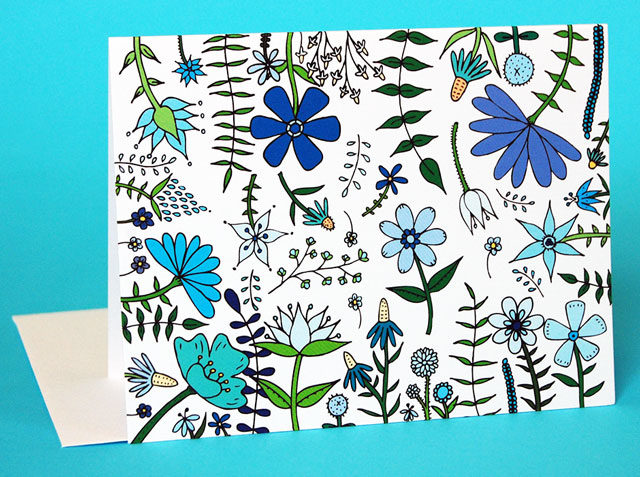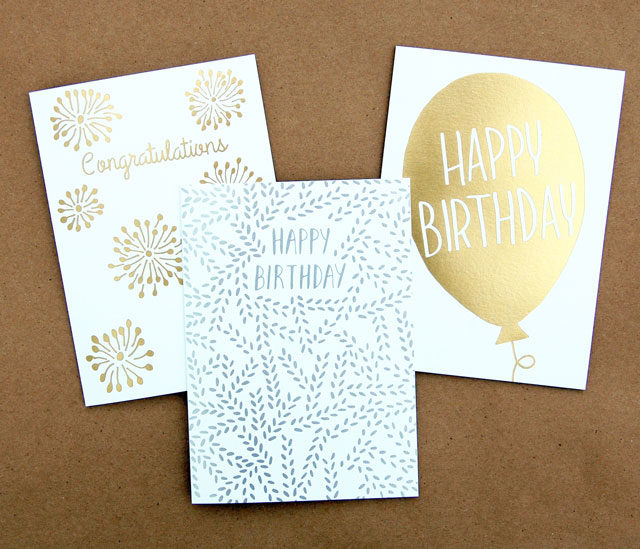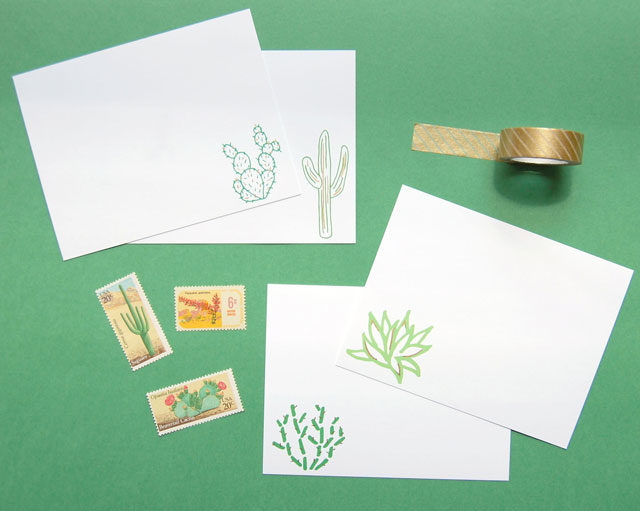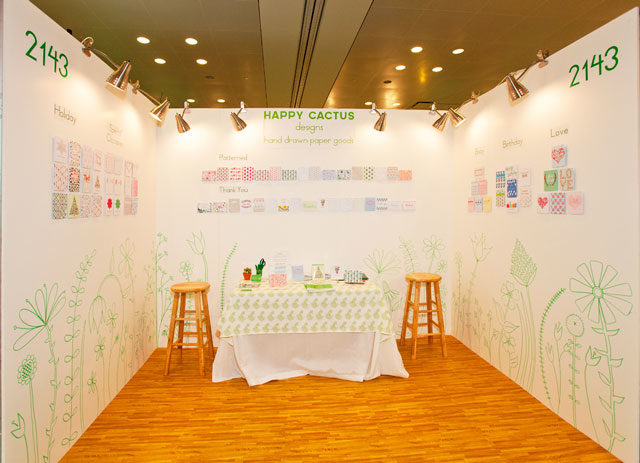It’s been such a fun week guest blogging here at OSBP. Thanks for following along with me! (Don’t forget, OSBP readers get 25% off all items in the Happy Cactus shop through June 15. Use code OSBP25 at checkout.) I am often asked how I got my start in this industry and thought that as we wrap things up I could offer some thoughts and pieces of advice for those of you who may be thinking of launching your own stationery or greeting card line.
One of the greatest things I love about the community of stationery and greeting card designers is that it is truly is a welcoming community that supports newbies. I received so much advice and assistance when I launched Happy Cactus Designs’ first collection in 2011. I never imagined how nice and helpful fellow designers would be to me. I was also fortunate enough to take a continuing ed class on launching a greeting card business at New York’s School of Visual Arts with Joyce Wan and shortly thereafter took Tradeshow Bootcamp’s webinars. Both helped immensely and introduced me to many good friends I’ve made in this industry.

One of my very first card designs that is still a best seller years later!
So, Where to Begin?
Do you have dreams of crafting a collection of greeting cards? Have you just opened an online shop? Are you thinking about exhibiting at a tradeshow? Here’s some valuable tips I’ve learned along the way.
- Create a cohesive collection that exemplifies your own personal style. Think about what distinguishes your work from everyone else’s out there. Is it your spectacular hand lettering? Your innovative printing method? Your funny puns and play on words? Play to your strengths and focus on what makes your work unique. It takes a lot of work to build an initial collection, but debuting with 20+ designs will help give people a greater sense of what your work is all about.
- Do your own research on the industry and build relationships with vendors. I can’t tell you how much time I spent Googling questions as I designed my initial collection and laid the groundwork for what would become Happy Cactus Designs. (Full disclosure: I still spend a ton of time with my pal Google. The struggle never ends.)
- Invest in getting samples of your work from various printers if you are outsourcing the job. Research local printers and online printing options. Don’t be afraid to ask questions either. Coming from a non-design school background, I had no idea what the difference between RGB and CMYK was or how to set up a file with bleeds. Just ask!
- Trial and error: Trust me, it takes a LOT of trial and error to get things right. Every designer has a story about the cards that were printed incorrectly, or the catalogs with horrible ink bleeds, or the printing press that broke down just as a big print run was to begin. Just remember it’s all part of the learning process!
- Observe what is happening in the stationery industry. OSBP is the best resource for doing this as Nole has her finger on the pulse of all things paper. Stationery Trends, a quarterly magazine targeted specifically to the trade, is another great place to scope out new trends and to read interviews with both designers and shop owners.
- Be respectful of other designers. Each has been in your position and while some may freely share their sources/vendors, others may be reticent to share this information as they have spent a lot of time working to get things right (see the points above!).

I introduced a line of foil stamped cards at the National Stationery Show in 2013. Adding a new method of printing to my collection took many, many hours of research, not to mention a large investment. That big gold balloon makes me so happy.

Over the years I’ve learned techniques to improve my product photography. It takes a lot of time and practice and many outsource this job. You can imagine my surprise when the shot above was featured on the cover of Stationery Trends!
- Think about how you want to sell your cards:
- Research and sign up for local craft fairs. Listen closely to customers as they can provide a wealth of feedback on your products. Are they looking for particular types of cards? What designs are they responding to? Are your price points on target?
- Consider an online storefront: Etsy or your own shop, or both. I could write an entire post on my thoughts about the two (I run my own e-commerce site via Shopify and have an Etsy storefront that plays second fiddle to my store). Each has its own set of pros and cons and building an online shop takes a tremendous amount of work upfront. From product photography and marketing to packaging and shipping, it’s no small feat to open an e-commerce site, but it’s one of the best ways to establish your brand.
- If you are thinking about dipping your toes in the wholesale pool, seek out opportunities to learn how it all works. It is an entirely different beast. My personal favorite learning tools include Tradeshow Bootcamp, Eva Jorgensen of Sycamore Street Press’ class on Atly, local continuing ed classes, Emily’s brilliant Brick and Mortar column here on OSBP, and Meryl Hooker and Rob Fortier’s book on the industry. I’ve also found that talking to shop owners I’ve grown friendly with is a great way to get pointed advice about the world of wholesale.

My first booth at the National Stationery Show in 2012. Exhibiting at a tradeshow takes a tremendous amount of work. Looking back, there’s many things about my debut that I’m proud of and many things I’d change. Drawing on the walls, while risky, was my favorite part.
- Say yes to new opportunities! Some of my best learning experiences came from just saying yes to new projects, inquiries, professional development opportunities, and events.
Please feel free to offer your own words of wisdom or ask questions in the comments below!

Aah it’s so great to hear stories of others’ struggles and successes! And i feel like you’ve read my mind! I started in a similar way and also took Joyce’s class at SVA! She is so great! It’s tough not to compare when you see all the amazing stuff on instagram, but I was just discussing with a friend how I’ve created a signature style and while trends are great, it is important to keep to your individual style. Also, it’s easy to show all the pretty shots on social media, but only fellow designers and illustrators understand the struggles we go through trying to perfect a product! So to those who want to jump in, it will take time, it will take hard work, but if you love what you do, you’ll enjoy the struggle (for the most part haha) and that feeling of accomplishment when your product comes to life is just heavenly. Dream, but also do!
Hi Natasha! Thanks so much for your comment and loved hearing that you also took Joyce’s class! I so agree with sticking to your own style – it helps to really establish your brand and show customers/retailers that you really know how to stand out/aren’t just trying to imitate what already sells well. Hope you had a great time at NSS!
Hi Brannon! Thanks so much for sharing all of this insight! I’m a calligrapher and just launched my own Etsy shop. I also did my first trade show last week. I only sold one item, but considering that I had never sold anything before, I count that one sale as a success. Here’s my question for you: when you design your cards/stationery, do you design something solely because it’s something that you want to design, or do you take other people’s needs/wants into consideration. In your post, you mentioned that you get feedback from other people, especially at trade shows. So I was just wondering, how often do you take that feedback and incorporate it into your designs? I think that’s what I am trying to learn is how to find that balance between creating what I really want to create and then catering to what people will actually buy. Thanks!!
Hi Lori, Your work is great! And congrats on taking the plunge and selling your work! I like your perspective of counting that one sale as a success – we all have to start somewhere and it only gets better over time. To answer your question – for me designing is a mix of both my own desires and feedback I get. I usually start with what *I* want to do – whether it’s a particular pattern design or sentiment. As I have sold more and talked to more retailers + customers, I’ve tried to hone in on what people are looking for while sticking true to my own style. For example, I launched art prints after hearing a lot of feedback that my card designs would look great hung on a wall or in nurseries. Oftentimes I’ve found that I hear from others about different occasions they would like cards for – whether it’s mom friends saying they don’t have any good cards to accompany baby shower gifts or retailers saying that they are looking for Valentines for children, etc. etc. which helps direct where I take my designs. So I listen to that feedback, decide which of it I want to take, and move forward. Hope that helps!
Yes, that definitely helps! Thank you for your feedback and for sharing part of your process!
Brannon, thanks for the reminders and tips. I dipped my toes into the wholesale and showed at the NSS for the first time this year It was a real education! Lots of good feedback and contacts. Love your work!
Hi Sonja, Thanks so much for your comment – glad you found the post helpful. I hope you had a great first showing at NSS – it is a TON of work!
I’m an illustrator trying to fully break into the stationery world. This was so helpful and im writing all your tips in my notebook! It’s a lot of research and stress, as I’m focusing on stationery for the African American community. Thanks for the encouragement.
Hey –
Despite its age, your overview is still one of the best presentations out there! <3
I'm curious about a few avenues that you didn't mention, like selling the designs to a bigger/parent company, but am not really sure what the situation is like nowadays compared to greeting card companies back in the day. I am not really wanting to put all of my focus into doing my own stationary, but having stationery available with my designs would work well with my business model.
Alternatively, is there a suggestion you might offer for finding a printing company that would be more suitable for notepads, colouring books, and/or journals? At this time, I have gotten a few items, like postcard prints and stickers through Vistaprint, but the options offered don't suit my needs well or affordably. (I'm based in Canada)